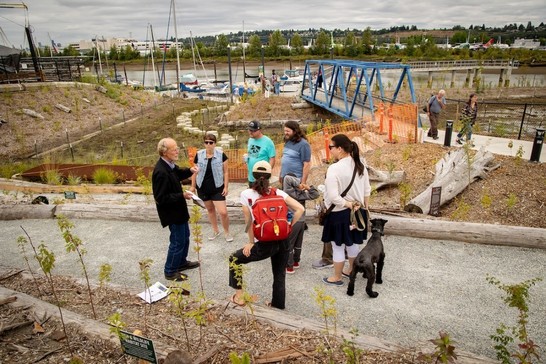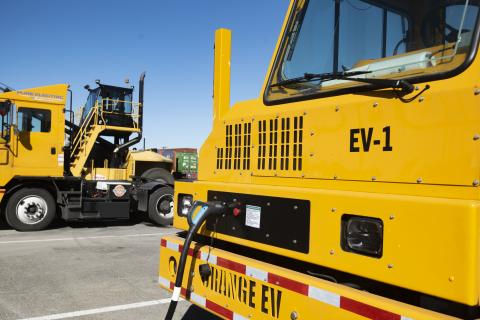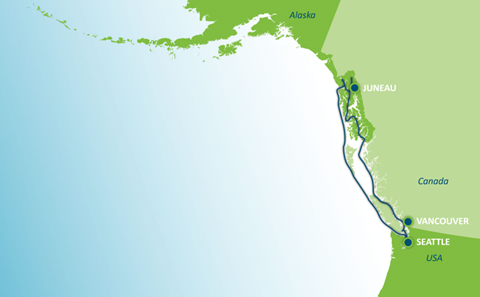|
The Clean Air Quarterly is a newsletter for port-related climate and clean air activities. Stay up to speed on the exciting environmental and sustainable projects and partnerships at the Northwest Seaport Alliance, Port of Tacoma and Port of Seattle.
 |
Saturday, July 16, 2022 marked the grand opening of the Duwamish River People’s Park and Shoreline Habitat (formerly Terminal 117), the largest habitat restoration site along the Duwamish River in a generation. The site, which is located on the ancestral site of the Indigenous water-related place, ł(ə)gʷalb, referring to an abandoned or old river channel, took decades to restore. The Port originally acquired the property in 1999 to build a cargo terminal. In 2003, the EPA designated the site as a highly toxic “Early Action” Superfund site. In 2007, the Duwamish Valley community advocated for the Port to pursue a higher standard of cleanup to transform the site into a public use park. Cleanup completed in 2016 and construction of the park broke ground in 2020. The 14-acre public park and shoreline habitat is now open for all to enjoy views of the Duwamish River and its shoreline marsh habitat from an elevated river walkway, explore a walking path with a hand-carried boat launch, and view public art designed with the community. [Read More]
This year, the Port and other public and private entities across the Puget Sound Region that include the ports of Anacortes, Everett, Olympia, Tacoma, Seattle and the Northwest Seaport Alliance, private industry associations, and government agencies will update the Puget Sound Maritime Air Emissions Inventory, a study that estimates emissions from port and other maritime activities in the Puget Sound airshed. Conducted every five years, it is a foundational element of the Port’s clean air and climate programs allowing us to identify major sources of climate and air pollution and track emission trends and progress over time. To date, Puget Sound Maritime Air Emissions Inventory studies have been conducted in 2005, 2011, and 2016. This next Inventory will look at emission levels during 2021. The study is expected to be complete in 2023. [Read More]

In March, three Orange EV battery-electric terminal tractors began operating at the South Intermodal (SIM) Yard in Tacoma, marking the first deployment of zero emission cargo handling equipment in our Tacoma-Seattle cargo gateway. In June, the second group of three electric yard tractors were delivered to the SIM Yard in Tacoma, capping off the project highlighted in last month’s Clean Air Quarterly. The new battery electric terminal tractors are displacing diesel-powered tractors. All six of the electric yard tractors have now been integrated into regular operations and are working well! More information can be found in our March press release.
|

On May 17, 2022, the Port of Seattle, City and Borough of Juneau, Vancouver Fraser Port Authority, Carnival Corporation, Norwegian Cruise Line Holdings, Royal Caribbean Group, Cruise Lines International Association, the Global Maritime Forum, Blue Sky Maritime Coalition, and Washington Maritime Blue launched a collaborative effort to explore the feasibility of a maritime green corridor aimed at accelerating the deployment of zero greenhouse gas emission ships and operations between Alaska, British Columbia, and Washington. The communities of Sitka and Skagway in Alaska and the Greater Victoria Harbour Authority have also joined the partnership. [Read More]
|

Port of Seattle, in partnership with the Northwest Seaport Alliance and Seattle City Light, are leading the development of the Seattle Waterfront Clean Energy Strategy, an innovative Port-Utility-Maritime Industry partnership to decarbonize the waterfront. The project team recently completed a baseline analysis of current energy use and infrastructure and will use that information to evaluate the clean energy infrastructure investments needed to support a transition to zero-emission maritime operations. [Read More]
|

Tacoma Power, a division of Tacoma Public Utilities, is the sole power provider for the Port of Tacoma. It is an innovative, citizen-owned electric utility that generates, transmits, and distributes electricity, and provides energy services in an increasingly competitive market. Tacoma Power staff helped create the City of Tacoma's 2030 Climate Action Plan (CAP). The CAP supports zero-emission technology innovation in the marine, trucking, and rail sectors, as well promotes electric vehicle and e-bike use in low-opportunity neighborhoods. Decarbonization through electrification is a major priority of the CAP. In recent years the Port of Tacoma, The Northwest Seaport Alliance, and Port of Tacoma have partnered on a number of impactful electrification projects that will reduce emissions in the Tacoma Harbor.
To get the utility’s perspective on our collaborative projects, we interviewed Jeremy Stewart, a Power Analyst at Tacoma Power who has worked closely on these projects.
In general, Tacoma Power’s motivations for working closely with the port on these projects was to reduce air and climate pollution and provide excellent customer service. When asked how these projects fit in with Tacoma Power’s environmental initiatives, Jeremy said, “we want to maximize use of clean, renewable hydroelectric energy, and a good way to do that is to partner with organizations to use power as efficiently as possible for new uses. It’s in our strategic objectives to work with community partners like the port, which has been a great relationship to help the environment and use our clean power to displace fossil fuels.”
The first of our collaborative projects was working together to develop a special electricity rate tariff and designing a system that will enable vessels calling at Husky Terminal to plug in and deliver clean, renewable hydroelectric energy to ships at berth, reducing the use of diesel generation for ship systems while at berth. The special rate creates cost predictability and streamlines the billing process for shipping lines that use shore power.
The second is the South Intermodal Yard electric yard tractor project highlighted in this issue of the Clean Air Connection and our Q1 issue. To advance this and other material handling electrification efforts, Tacoma Power launched a pilot program in 2020 to encourage cargo and material handling equipment electrification with funding from their Electric Vehicle Charging Station Fund. Tacoma Power supported the SIM Yard project with a $132,000 incentive to help pay for the charging infrastructure required.
Tacoma Power sees these projects as a great way to demonstrate emission reduction technology. Specifically, Jeremy’s thoughts were, “the yard truck project is a good opportunity because these trucks drive short distances and are ideal demonstration for battery technology. It’s the first time it’s being done in the northwest, so we’re excited to do these. The Husky shore power project is a great opportunity for us to reduce emissions by using our clean, renewable electricity to fuel ships at the port.”
There have been a number of lessons learned as we’ve worked through these two projects. At the top of the list are that electrification is complex and that getting an early start on planning and coordination is imperative. When we asked Jeremy to talk about the lessons learned from his perspective, his thoughts were, “Tacoma Power is always looking for ways to work with partners to come up with better ways to implement new technology and equipment. Upfront communication helps everybody be successful. Come talk to us as soon as you know you’re anticipating adding a large load like this. In this way, the port has been a great partner, because communications began before ordering equipment, allowing Tacoma Power to make sure capacity was available to start as soon as equipment arrived.”
Learn more about Tacoma Public Utilities here.
|
|